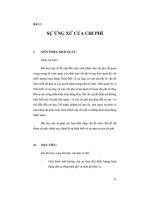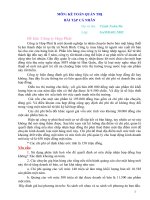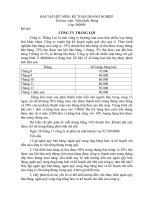Kế Toán Quản Trị 2 (MA2) - IUH
Bạn đang xem bản rút gọn của tài liệu. Xem và tải ngay bản đầy đủ của tài liệu tại đây (1.69 MB, 34 trang )
Chapter 1 : Absorption and Marginal costing
1/ Marginal costing
Sales = Selling price * Units
XXX
Cost of sales :
+ Opening inventory
XXX
+ Variable production costs
XXX
+ Variable direct material
XXX
+ Variable direct labor
XXX
+ Variable production overhead
XXX
+ Closing inventory
🡪 Variable cost of sales (or Marginal cost of production)
XXX
Variable selling cost and administrative cost
XXX
Contribution
XXX
= Sales – Variable cost of sales – Variable selling cost …
Fixed costs (fixed production overhead, fixed selling cost,
fixed administrative cost)
XXX
Profit = Contribution – Fixed cost
XXX
1
2/ Absorption costing
Sales = Selling price * Units
XXX
Cost of sales
XXX
+ Opening inventory
XXX
+ Production costs
XXX
+ Variable direct material
XXX
+ Variable direct labor
XXX
+ Variable production overhead
(XXX)
(XXX)
+ Fixed production overhead
+ Closing inventory
🡪 Cost of sales
Gross profit = Sales – Cost of sales
XXX
Selling and administrative costs
(XXX)
+ Variable selling and administrative costs
(XXX)
+ Fixed selling and administrative costs
Profit = Gross profit – Selling and administrative costs
XXX
3/ Profit between Marginal costing and Absorption costing
a) If Closing Inventory > Opening Inventory
=> AC profit > MC profit
=> AC profit – MC profit = Difference in Profit
b) If Closing Inventory < Opening Inventory
=> AC profit < MC profit
=> MC profit – AC profit = Difference in Profit
Difference in profit
2
= ( CI – OI ) x Manufacturing Overhead Absorption rate per unit
= ( CI – OI ) x
𝐵𝑢𝑑𝑔𝑒𝑡𝑒𝑑 𝑀.𝑂
𝐵𝑢𝑑𝑔𝑒𝑡𝑒𝑑 𝐿𝐻/𝑀𝐻
x Actual LH/MH per unit
= ( CI – OI ) x Overhead absorption rate x Actual LH/MH per unit
4/ Inventory valuation between Marginal costing and Absorption costing
a) If Closing Inventory > Opening Inventory
=> AC inventory valuation > MC inventory valuation
=> AC inventory valuation – MC inventory valuation = Difference in inventory
a) If Closing Inventory < Opening Inventory
=> AC inventory valuation < MC inventory valuation
=> MC inventory valuation – AC inventory valuation = Difference in inventory
Difference in Inventory valuation
= ( CI – OI ) x Manufacturing Overhead Absorption rate per unit
= ( CI – OI ) x
𝐵𝑢𝑑𝑔𝑒𝑡𝑒𝑑 𝑀.𝑂
𝐵𝑢𝑑𝑔𝑒𝑡𝑒𝑑 𝐿𝐻/𝑀𝐻
x Actual LH/MH per unit
= ( CI – OI ) x Overhead absorption rate x Actual LH/MH per unit
CHAPTER 1
1/
Using marginal costing :
Variable production cost
= Variable material + Variable labour + Variable production overhead
= 9.80 + 8.70 + 1.35 = $19.85 / unit
=> The value of closing inventory = 19.85 * 4,300 = $85,355
3
2/
Fixed production overhead absorption rate = $6.50 per labour hours
Fixed production overhead (Product S ) = 6.50 * ( 60/12) = $32.5/unit
Production cost = 60 + 70 + 32.5 = $162.5 / unit
Closing inventory ( AC ) = 65,000 = Units * Production cost
⬄ 65,000 = Units * 162.5 = 400 units
Variable production cost = 60 + 70 = $130 / unit
Closing inventory ( MC ) = Units * Variable production cost
= 400 * 130 = $52,000
3/
Sales = Units * Selling price = 800 * 50 = $40,000
Production cost = 1,000 * 25 = $25,000
Closing inventory = ( 1,000 – 800 ) * 25 = $5,000
Variable cost of sales = 25,000 – 5,000 = $20,000
Contribution = 40,000 – 20,000 = $20,000
4
Fixed cost = 5,000
=> The profit = 20,000 – 5,000 = $15,000
4/
Gross profit = 16,000 * ( 24 – 8.50 – 2.50 ) = $208,000
Selling cost = 16,000 * 6.00 = $96,000
Over absorbed fixed cost = ( 16,400 – 15,900 ) * 2.50 = $1,250
Absorption costing profit = 208,000 – 96,000 + 1,250 = $113,250
5/
Sales = 800 * 250 = $200,000
Variable production cost = $95,500
Fixed production cost per unit = 25,800 / 1,000 = $25.8 / unit
Opening inventory = 0 , Closing inventory = 1,000 – 800 = 200 units
Closing inventory > Opening inventory
=> AC profit – MC profit = Difference in profit
AC profit – MC profit = ( 1,000 – 800 ) * 25.8 = 5,160
=> AC profit > MC profit : $5,160
=> Higher $5,160
6/
5
Opening inventory = 0 unit
Closing inventory = 250 units
Fixed production cost per unit = 30,000 / 750 = $40/unit
Closing inventory > Opening inventory
=> AC profit > MC profit
=> AC profit – MC profit = Difference in profit
AC profit – MC profit = (CI –OI )*Manufacturing overhead absorption rate per unit
= ( 250 – 0 ) * 40 = 10,000
=> MC lower higher $10,000
7/
Profit using Marginal costing = $60,000
Opening inventory = 3,000 units
Closing inventory = 3,000 + 8,000 – 8,500 = 2,500 units
Closing inventory < Opening inventory
=> AC profit < MC profit
=> MC profit – AC profit = Difference in profit
6
60,000 – AC profit = ( CI – OI ) * Manufacturing overhead absorption rate per unit
60,000 – AC proft = ( 2,500 – 3,000 ) * 5
=> AC profit = $57,500
8/
Opening inventory = 48,500 units
Closing inventory = 45,500 units
MC profit = $315,250
AC profit = $288,250
Closing inventory < Opening inventory
=> AC profit < MC profit
=> MC profit – AC profit = Difference in profit
⬄315,250 – 288,250 = ( 48,500 – 45,500 )*Fixed overhead absorption rate per
unit
=> Fixed overhead absorption rate per unit = $9 / unit
9/
Opening inventory = 760 units
Closing inventory = 320 units
MC profit = $78,000
Closing inventory < Opening inventory
=> AC proft < MC profit
=> MC profit – AC profit = Difference in profit
⬄ 78,000 – AC profit = ( 760 – 320 ) * Fixed overhead absorption rate per unit
7
⬄ 78,000 – AC profit = ( 760 – 320 ) * 5
=> AC profit = $75,800
10/
Absorption rate per unit ( Machinning ) = 120,000 / ( 4,000 * 0.5 + 4,000 * 1 )
= $20/hours
Machinning cost of a units of Pye = $20/hours * 0.5 hours = $10 / unit
Absorption rate per unit ( Assembly ) = 72,000 / ( 4,000 * 0.2 + 4,000 * 0.25 )
= $40/hours
Assembly cost of a units of Pye = $40/hours * 0.2 hours = $8 / unit
The fixed overhead cost of a unit of Pye = 10 + 8 = $18/unit
11/
Sales = 70,000 units * 8 = $560,000
Production cost per unit = 6.00 + 90,000/75,000 = $7.2 / unit
Production cost = 75,000 * 7.2 = $540,000
Closing inventory = ( 75,000 – 70,000 ) * 7.2 = $36,000
Cost of sales = 540,000 – 36,000 = $504,000
Gross profit = 560,000 – 504,000 = $56,000
8
Selling and Administrative cost = 70,000*0.2 + 22,500 = $36,500
Profit = 56,000 – 36,500 = $19,500
12/
Sales = 10,000 * 10 = 100,000
Cost of sales :
- Opening inventory = 0 * 6 = 0
- Variable production cost = 20,000 * 6 = 120,000
- Closing inventory = ( 20,000 – 10,000 ) * 6 = 60,000
=> Variable cost of sales
= 0 + 120,000 – 60,000 = 60,000
Variable selling and Administrative cost = 0
Contribution = 100,000 – 60,000 = 40,000
Fixed cost = 45,000
Profit = 40,000 – 45,000 = (5,000)
Sales = 15,000 * 10 = 150,000
Cost of sales :
- Opening inventory = 0 * 6 = 0
- Variable production cost = 20,000 * 6 = 120,000
- Closing inventory = ( 20,000 – 15,000 ) * 6 = 30,000
=> Variable cost of sales
= 0 + 120,000 – 30,000 = 90,000
Variable selling and Administrative cost = 0
Contribution = 150,000 – 90,000 = 60,000
Fixed cost = 45,000
Profit = 60,000 – 45,000 = 15,000
Sales = 20,000 * 10 = 100,000
100,000
0
120,000
60,000
60,000
0
40,000
45,000
(5,000)
150,000
0
120,000
30,000
90,000
0
60,000
45,000
15,000
200,000
9
Cost of sales :
- Opening inventory = 0 * 6 = 0
- Variable production cost = 20,000 * 6 = 120,000
- Closing inventory = ( 20,000 – 20,000 ) * 6 = 0
=> Variable cost of sales
= 0 + 120,000 – 0 = 120,000
Variable selling and Administrative cost = 0
Contribution = 200,000 – 120,000 = 80,000
Fixed cost = 45,000
Profit = 80,000 – 45,000 = 35,000
0
120,000
0
120,000
0
80,000
45,000
35,000
13/
The Loo :
Variable production cost = Variable material + Variable labour + Variable
production overhead = 8 + 4 + 2 = $14/unit
Sales = 20 * 10,000 = 200,000
Cost of sales :
- Opening inventory = 0 * 14 = 0
- Variable production cost :
+ Variable material = 15,000 * 8 = 120,000
+ Variable labour = 15,000 * 4 = 60,000
+ Variable produdction overhead = 15,000*2 = 30,000
- Closing inventory = ( 15,000 – 10,000 ) * 14 = 70,000
=> Variable cost of sales
= 0 + 120,000 + 60,000 + 30,000 – 70,000 = 140,000
200,000
0
120,000
60,000
30,000
70,000
140,000
10
Variable selling and Administrative cost
= 10,000 * 2 = 20,000
20,000
Contribution = 200,000 – 140,000 – 20,000
40,000
The Wash :
Variable production cost = Variable material + Variable labour + Variable
production overhead = 14 + 2 + 1 = $17/unit
Sales = 30 * 5,000 = 150,000
Cost of sales :
- Opening inventory = 0 * 17 = 0
- Variable production cost :
+ Variable material = 6,000 * 14 = 84,000
+ Variable labour = 6,000 * 2 = 12,000
+ Variable produdction overhead = 6,000 * 1 = 6,000
- Closing inventory = ( 6,000 – 5,000 ) * 17 =17,000
=> Variable cost of sales
= 0 + 84,000 + 12,000 + 6,000 – 17,000 = 85,000
Variable selling and Administrative cost
= 5,000 * 3 = 15,000
Contribution = 150,000 – 85,000 – 15,000
150,000
0
84,000
12,000
6,000
17,000
85,000
15,000
50,000
The total contribution = 40,000 + 50,000 = $90,000
The total fixed cost = 40,000 + 15,000 = 25,000 = $80,000
=> The profit = 90,000 – 80,000 = $10,000
14/ $295,000
11
15/ a)Higher $3,600 ; b)52,500 units
16/ a) $9/unit ; b) $74,550 ; c) $40,000/$35,000
12
17/ 10,000 / 40,000 / 70,000
18/ $113,750
13
19/ $2,600 Loss
20/ $74,400
21/ $65,000
14
22/ $68,600
CHAPTER 3
1/ Direct material variance
Budgeted / Standard
1 unit X = ……. Kilograms/unit
1 Kilograms = ………. $/unit
1 unit X = ……..$ / unit
Actual
Production =…… unit =……kilograms
= ……$
1 unit X = ……. Kilograms/unit
1 Kilograms = ………. $/unit
1 unit X = ……..$ / unit
a) Direct material total variance :
The number of products ( Actual ) x
Direct material per unit ( Budgeted )
The number of products ( Actual ) x
Direct material per unit ( Actual )
=> The total direct material variance = (F) / (A) $ / unit
b) Direct material price variance :
The number of Kilograms ( Actual ) x Direct material per kilograms ( Budgeted )
The number of Kilograms ( Acutal ) x Direct material per kilograms ( Actual )
15
=> The price direct materil variance =
(F) / (A) $ / unit
c) Direct material usage variance ( Direct material efficiency variance )
The number of products ( Actual ) x The number of Kilograms per unit (Budgeted)
The number of products ( Acutal ) x The number of Kilograms per unit (Actual )
=> Usage Variance in Kilograms = (F) / (A) Kilograms
x Standard rate per Kilograms : …… $ / Kilograms
=> The usage material variance = (F) / (A) $ / unit
2. Diret labor variances :
Budgeted / Standard
1 unit X = ….. labor hours/unit
1 labor hours = ….. $/ labor hours
1 unit X = …. $/unit
Actual
Products = ……units = ….. labor hours
= …...$
1 unit X = ….. labor hours/unit
1 labor hours = ….. $/ labor hours
1 unit X = …. $/unit
a) Direct labor total variance :
The number of products ( Actual ) x Direct labor per unit ( Budgeted )
The number of products ( Actual ) x Direct labor per untit ( Actual )
=> The total direct labor variance = (F) / (A) $ / unit
b) Direct labor rate variance :
The number of labor hours (Actual) x Direct labor per labor hours ( Budgeted )
16
The number of labor hours (Actual) x Direct labor per labor hours ( Actual )
=> The rate direct labor variance = (F) / (A) $ / unit
c) Direct labor efficiency variance :
The number of products ( Actual ) x The number of labor hours per unit (Budgeted)
The number of products ( Actual ) x The number of labor hours per unit (Actual)
=> Efficiency variance in labor hours = (F) / (A) labor hours
x Standard rate per hours
= …. $ / labor hours
=> The efficiency direct labor variance = (F) / (A) $/unit
3. Manufacturing overhead variances ( Variable overhead expenses)
Budgeted / Standard
Actual
Products = …units = …..machine hours
= …...$
1 unit X = ….. machine hours/unit
1 unit X = ….. machine hours/unit
1 machine hours = ….. $/machine hours 1 machine hours = ….. $/machine
1 unit X = …. $/unit
1 unit X = …. $/unit
a) The variable overhead total variance
The number of products ( Actual ) x Variable P.O per unit ( Budgeted )
The number of products ( Actual ) x Variable P.O per unit ( Actual )
=> The variable production overhead total variance = (F) / (A) $/unit
17
b) The variable production overhead expenditure variance
The number of machine hours (Actual) x Variable P.O per M.H (Budgeted)
The number of machine hours (Actual) x Variable P.O per M.H (Actual)
=> The variable production overhead expenditure variance = (F)/(A) $/unit
c) The variable production overhead efficiency variance
The number of products (Actual) x The number of MH per unit ( Budgeted )
The number of products (Actual) x The number of MH per unit (Actual)
=> Variable MO efficiency variance in machine hours = (F)/(A) machine hours
x Standard rate per hours = …. $/ machine hours
=> The variable MO efficienct variance in $ = (F)/(A) $/unit
1. Dạng bài có cho số lượng sản phẩm sản xuất (X)
Phải lập bảng :
Budgeted / Standard
1 unit X = (1) Kg/hours
1 Kg,Hours = (2) $/kg or $/hours
1 unit X = (3) $/unit
Actual
Product : X unit = Y kg,hours
= …….$
1 unit X = (4) Kg/hours
1 Kg,Hours = (5) $/kg or $/hours
1 unit X = (6) $/unit
Ra âm là (A) , Ra dương là (F) : Đáp án chỉ lấy số không lấy dấu
Total variance = X*(3) - X*(6) = Đáp án
Price variance = Rate variance = Y*(2) – Y*(5) = Đáp án
Efficiency variance = Usage variance = X*(1) – X*(4) = …… x (2) = Đáp án
18
* Price variance : Dùng Y là số lượng mua ( Không dùng số lượng sử dụng )
2. Dạng bài không cho số lượng sản phẩm sản xuất (X)
Ra âm là (A) , Ra dương là (F)
AH : Actual hours
AR : Actual rate
SH : Standard hours
SR : Standard rate
- Rate = Price : Đơn vị là $/hours or $/kg …
- Hours = Kilograms = Quantity : Đơn vị là Kg , Hours , ….
1. Total ( direct material / Labor / Production overhead ) variance :
= ( SR * SH ) – ( AR * AH )
2. Price (Rate) ( Direct material/labor/production overhead) variance :
= ( SR – AR ) * AH
3. Efficiency (Usage) ( Direct materia/labor/production overhead) variance :
= ( SH – AH ) * SR
3. Dạng Sale volume :
= (Số lượng bán ước tính – Số lượng bán thực tế) * (Giá bán ước tính – cp ước tính)
Giá bán ước tính = Tổng trị giá bán ước tính / Số lượng bán
= Sales value / sales units
Chi phí bán ước tính = Tổng chi phí / số lượng bán
= Variable ( Fixed ) cost / Sales unit
19
Standard / Budgeted
1unit = 10 Kg/unit
1Kg = $10/Kg
1unit = $100/unit
Actual
Product : 1,000 units = 11,700 kg = $98,600
1unit = 11.7 Kg/unit
1Kg = 98,600/11,700 $/Kg
1unit = $98.6/unit
a) The direct material total variance :
The number of product (Actual) x Direct material per unit (Budgeted)
= 1,000 units x $100/unit = $100,000
The number of product (Actual) x Direct material per unit (Acutal)
= 1,000 units x $98.6/unit = $98,600
=> The direct total variance = $1,400/unit (F)
b) The direct material price variance :
The number of Kilogram (Actual) x Direct material per kilograms (Budgeted)
= 11,700 Kg x $10/kg = $117,000
The number of Kilogram (Actual) x Direct material per kilograms (Actual)
= 11,700 Kg x $98,600/11,700 Kg = $98,600
=> The direct material price variance = $18,400/unit (F)
c) The direct material usage variance :
The number of product (Actual) x The number of kilograms per unit (Budgeted)
= 1,000 units x 10Kg/unit = 10,000 Kg
The number of product (Actual) x The number of kilograms per unit (Actual)
= 1,000 units x 11.7Kg/unit = 11,700 Kg
=> Usage variance in Kilograms = 1,700 Kg (A)
x Standard rate per Kilograms : $10/kg
=> The direct material usage variance = $17,000/unit (A)
----------------------------------------------------------------------------------------------------20
2/
Standard / Budgeted
1unit = 2 LH/unit
1LH = $5/LH
1unit = $10/unit
Actual
Product : 1,000 units = 2,300 LH = $8,900
1unit = 2.3 LH/unit
1LH = (8,900/2,300) $/LH
1unit = $8.9/unit
a) The direct labor total variance :
The number of product (Actual) x Direct labor hours per unit (Budgeted)
= 1,000 units x $10/unit = $10,000
The number of product (Actual) x Direct labor hours per unit (Actual)
= 1,000 units x $8.9/unit = $8,900
=> The direct labor total variance = $1,100 / unit (F)
b) The direct labor rate variance
The number of labor hours (Actual) x Direct labor per labor hours (Budgeted)
= 2,300 labor hours x $5/labor hours = $11,500
The number of labor hours (Actual) x Direct labor per labor hours (Actual)
= 2,300 labor hours x $ (8,900/2,300) labor hours = $8,000
=> The direct labor rate variance = $2,600 / unit (F)
c) The direct labor efficience variance
The number of product (Actual) x The number of labor hours per unit (Budgeted)
21
= 1,000 units x 2 labor hours / unit = 2,000 labor hours
The number of product (Actual) x The number of labor hours per unit (Actual)
= 1,000 units x 2.3 labor hours / unit = 2,300 labor hours
=> Efficience variance in labor hours = 300 labor hours (A)
x Standard rate per labor hours : $5 / labor hours
=> The direct labor efficience variance = $1,500 / unit (A)
3/
Standard / Budgeted
1unit = 2 MH/unit
1MH = $1.5/MH
1unit = $3/unit
Actual
Product : 400 units = 760 MH = $1,230
1unit = 1.9 MH/unit
1MH = (1,230/760) $/MH
1unit = (1,230/400) $/unit
a) The variable overhead toal variance
The number of product (Actual) x Variable overhead per unit (Budgeted)
= 400 units x $3/unit = $1,200
The number of product (Actual) x Variable overhead per unit (Actual)
= 400 units x (1,230/400) $/unit = $1,230
=> The variable overhead total variance = $30/unit (A)
b) The variable production overhead expenditure variance
22
The number of machine hours (Acutal) x Variable overhead per MH (Budgeted)
= 760 machine hours x $1.5/MH = $1,140
The number of machine hours (Actual) x Variable overhead per MH (Actual)
= 760 machine hours x (1,230/760) $/MH = $1,230
=> The variable production overhead expenditure variance = $90/unit ()
c) The variable production overhead efficiency variance
The number of product (Actual) x The number of MH per unit (Budgeted)
= 400 units x 2MH/unit = 800 machine hours
The number of product (Actual) x The number of MH per unit (Actual)
= 400 units x 1.9MH/unit = 760 machine hours
=> Efficiency variance per Machine hours = 40 machine hours (F)
x Standard rate per machine hours : $1.5/MH
=> The variable production overhead efficiency variance = $60/unit (F)
1/ $3,750 (Adverse)
Price : Dùng số lượng mua , Không dùng số lượng sử dụng
Standard / Budgeted
1unit = 4 Kg/unit
1Kg = $5/Kg
1unit = $20/unit
Actual
Product : 2,500 unit = 25,000kg = $128,750
1unit = 10Kg/unit
1Kg = $5.15/Kg
1unit = $51.5/unit
The number of Kg (Actual) x Direct material per Kg (Budgeted)
= 25,000 kg x $5/kg = $125,000
23
The number of Kg (Actual) x Direct material per Kg (Actual)
= 25,000 kg x $5.15/kg = 128,750
=> The direct material price varince = $3,750 (Adverse)
2/ $4,000 hours
The number of labor hours (Actual) x Direct labor per unit (Budgeted)
=A x
$10/labor hours
The number of labor hours (Actual) x Direct labor per unit (Actual)
= $39,550
=> The direct labor rate variance = $450 (F)
=> A = 4,000
3/ $58.5 Favorable
The wage rate variance = ( SR – AR ) * AH = ( 5.40 – 4.95 ) * 130 = $58.50 (F)
4/ $7.36 Favorable
24
The total labor variance = ( SH * SR ) – ( AH * AR )
= ( 64.5 * 4.15 ) – ( 61.25 * 4.25 ) = $7.36 (F)
5/ 120,000Kg
The number of product (Actual) x The number of Kg per unit (Budgeted)
= 10,000 x 10 = 100,000 Kg
The number of product (Actual) x The number of Kg per unit (Actual)
= 10,000 x X = Y
=> Usage variance in Kg = Z (A)
x Standard rate per Kg : $1.5/unit
=> Usage variance = 30,000 (A)
=> Z = 20,000
=> Y = 120,000
=> Direct materal = 120,000 Kg
6/ $7.6 Adverse
25









